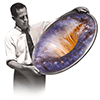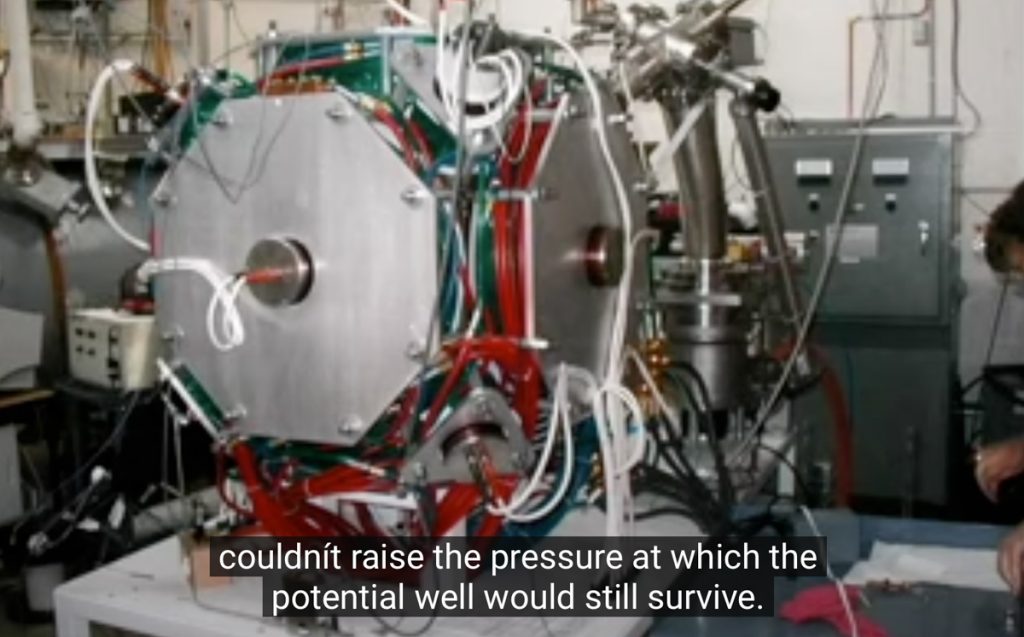Dr. Robert Bussard recently visited the Googleplex to discuss his latest developments in controlled nuclear fusion:
Or click here for a larger-screen version:
Should
Google Go Nuclear? Clean, cheap, nuclear power (no, really)
Description: Google Tech Talks November 9, 2006 ABSTRACT This is not your
father’s fusion reactor! Forget everything you know about conventional thinking
on nuclear fusion: high-temperature plasmas, steam turbines, neutron radiation
and even nuclear waste are a thing of the past. Goodbye thermonuclear fusion;
hello inertial electrostatic confinement fusion (IEC), an old idea that’s been
made new. While the international community debates the fate of the
politically-turmoiled $12 billion ITER (an experimental thermonuclear reactor),
simple IEC reactors are being built as high-school science fair projects. Dr.
Robert Bussard, former Asst. Director of the Atomic Energy Commission and
founder of Energy Matter Conversion Corporation (EMC2), has spent 17 years
perfecting IEC, a fusion process that converts hydrogen and boron directly into
electricity producing helium as the only waste product. Most of this work was
funded by the Department of Defense, the details of which have been under
seal… until now. Dr. Bussard will discuss his recent results and details of
this potentially world-altering technology, whose conception dates back as far
as 1924, and even includes a reactor design by Philo T. Farnsworth (inventor of
the scanning television). Can a 100 MW fusion reactor be built for less than
Google’s annual electricity bill? Come see what’s possible when you think
outside the thermonuclear box and ignore the herd.
– – – – –
This starts out as a pretty basic primer on the subject of fusion, how it differs from fission, etc. etc. There are at least two places where this subject and Bussard himself intersect with the Townsend Brown story, and so it is relevant for that reason. Not the least: you’re not going to get any electrically powered antigravity machine off the ground without a power source like a fusion reactor.
And, for whatever it’s “fusion” is the whole reason I’m here. It all began on a hill-top outside Santa Cruz, CA, in the summer of 1973, when somebody told me about Philo Farnsworth and the fusion reactor he built… and then dismantled. Or so the story goes…. maybe I’ll tell that story in a future post.
Perhaps the really interesting detail here is that an outfit like Google — obviously both innovative and deep-pocketed — is asking questions about their electricity bill…


This form of fusion has exactly the same high-temperature plasmas as the toroidal tokamaks. It’s just contained differently.
If it’s going to use p-B11 fusion the plasma will have to be even hotter.
This device Bussard is describing does not attempt to ignite a self-sustaining fusion plasma, as in a Tokamak. It is a “driven” system, like a power amplifier, as Bussard says in his patent. Fusion ions are compressed in a core region where all the ions are at the same energy, which is determined by the energy of the electron beams creating the negative potential well that electrostatically traps the fuel ions.
I enjoyed the lecture as well, and wrote it up as an article that you can find at:
http://www.askmar.com/Fusion.html
Here are some bits I have written on the subject:
http://powerandcontrol.blogspot.com/2007/03/mr-fusion.html
Bussard Fusion Reactor
http://powerandcontrol.blogspot.com/2006/11/easy-low-cost-no-radiation-fusion.html
Easy Low Cost No Radiation Fusion
It has been funded:
http://powerandcontrol.blogspot.com/2007/08/bussard-reactor-funded.html
Bussard Reactor Funded
I have inside info that is very reliable and multiply confirmed that validates the above story. I am not at liberty to say more. Expect a public announcement from the Navy in the coming weeks.
The above reactor can burn Deuterium which is very abundant and produces lots of neutrons or it can burn a mixture of Hydrogen and Boron 11 which does not
The implication of it is that we will know in 6 to 9 months if the small reactors of that design are feasible.
If they are we could have fusion plants generating electricity in 10 years or less depending on how much we want to spend to compress the time frame.
BTW Bussard is not the only thing going on in IEC. There are a few government programs at Los Alamos National Laboratory, MIT, the University of Wisconsin and at the University of Illinois at Champaign-Urbana among others.